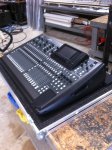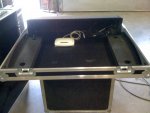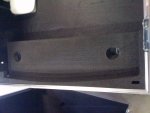re: X32 Discussion
Thank you for all your comments and suggestions.
In the interest of efficiency please allow me to clarify several topics in this one post:
96 kHz
This is a very interesting topic and one which receives plenty of discussion among our various digital engineering teams. Without taking sides in the debate over whether the differences are audible or even necessary in a live sound application, allow me to say that we have made a conscious decision to deliver the X32 with 44.1/48 kHz sample rates. As I have stated before, our goal with the X32 was to deliver a console that meets the real-world needs of the target customer and there are several reasons why that excludes a 96 kHz sample rate.
Most fundamental is the fact that as the sample rate doubles, so does the channel count drop by half. Of course we could add more DSP to maintain the channel count at the higher sample rate, but then the console would likely cost considerably more. Our job is to balance the feature set (channel count) and performance (sample rate) with a cost that makes sense for our customers. While we don’t count it out as a future possibility I would point people to the MIDAS Pro1 as an immediate alternative if they need the higher sample rate.
Why is the X32 so affordable?
This is such an important question because there is a lingering perception that we must somehow be cutting corners to reduce cost. I have seen people claim that we must be using poor quality parts, not following quality control processes or somehow designing in obsolescence. While I can tell you that this is absolutely not the case, it may be best if I offer some insights into our business model to explain.
There are four fundamental elements that comprise the selling price of our products; materials, labor, overhead and profit. Achieving low prices and delivering great value for our customers requires great discipline and hard work in each of these areas. It is my responsibility as the CEO to set the pace and ensure that we reduce costs while always increasing quality; because without quality, we cannot maintain low costs.
We reduce the cost of raw materials in two ways; first, we buy direct from manufacturers and not through a second source, distributor or contract manufacturer. Second, we buy in enormous quantities and leverage this volume in negotiating lower prices. Of course owning the factory where we build our products allows us to cut out at least 30% of the margin demanded by contract manufacturers who are supplying some of our competitors.
Consider that we buy our A/D and D/A converters from Cirrus Logic; the same parts (CS5368 and CS4385) that you will find in a $200k console; we encourage anyone interested to look further into this. We have also been told that we are the single largest Cirrus Logic customer behind only Apple! You will find similar examples with Analog Devices, makers of the SHARC DSPs that we use or Mabuchi, who make the motors for our motor-faders (and those of Penny & Giles, Alps etc.) and the list goes on. We are buying the very best parts, from the very best manufacturers, direct and in huge quantities. That means we pay the lowest possible prices.
Likewise we have two major ways in which we reduce the cost of labor to build our products. First, we own the factory and this means we are paying workers directly and not through a third party that is making a markup. Again, this results in up to 35% savings. Second, we have invested in massive amount of automation to a far greater extent than many in China in order to reduce cost while increasing quality.
This past year for example we converted the placement of electrolytic capacitors from hand-insertion to full automation. Each of the machines that now place e-caps in rapid-fire succession cost over $500k US so the savings in cost will take some time to be realized. But we have seen an immediate improvement in first-pass yield by eliminating the chance of human error, and that is both improving quality and reducing the cost of re-work.
We run our company with a very low overhead relative to some competitors, and we do this not by cutting corners but rather by working smarter. First off we invest heavily in systems that improve productivity and reduce redundancy. For example our engineering management software Agile talks to our website content management system so when we enter a product’s specifications we do it once and it is automatically replicated across several departments and is immediately posted to the web. Or take our service manuals which are created automatically, in real-time and with the very latest schematics, parts lists and engineering changes - all available through an on-line portal.
Another way we reduce overhead is by re-investing profits in our company to purchase machinery, land and buildings. For example we have purchased new buildings in Manchester, UK and Las Vegas, USA in the past year. We have also purchased land and we are building a $60 million state-of-the-art campus to contain a new factory, research center, logistics hub and residential village in China. These investments not only give us greater control over quality and production but they also reduce our operating costs over the long term.
Finally it is important to know that we operate on what would be considered to be a slim margin by industry standards. While some manufacturers price their products according to what they think the market will accept, we do it very differently. We calculate our costs and add a fair markup that will allow us to continue to grow our business and nothing more. Again, we have all seen strategies where manufacturers release new products at high prices only to reduce them as other competitors come into the market. We prefer to offer a fair price from the beginning and not play such games.
The reality of our company is that we are a highly efficient organization of 3,500 people including over 250 engineers and in-house manufacturing. We build up to 5 million products a year and consequently buy parts at the lowest possible cost. Plus, our quality is among the best in the world, with a defect rate of well under 0.7%, allowing us the confidence to offer a 3-year warranty.
Yes, we are a very different kind of company, we want to be different and I am immensely proud of our team.
X32 Manual
I have been asked why we did not issue a full manual when the console first shipped and when it can be expected to become ready. The truth is that we prepared a full manual and decided at the last moment not to release it as we felt it was too long and too complicated. So we set about rewriting the manual and including more illustrations and less text. The new manual should be posted online in the next couple of days but expect it to expand as we roll out new features and implement updates.
Generation 2 Firmware
Since the X32 has first become available we have received tremendous feedback and many suggestions for new features. While many of these suggestions reflect personal preferences we are open to hearing any and all ideas and promise to consider each of them for future revisions. We are already planning the future addition of dedicated function lockouts, which is one of the suggestions we heard from several of you.
One of the most exciting new features that we are planning for the X32 is the inclusion of high-end FX “plug-ins” based on physical modeling of classic audio hardware. Our algorithm development engineers are essentially “rebuilding” classics from Neve, SSL, UREI and others into effects that will be included on the X32. Well-known and loved gear such as the LA-2A compressor, Lexicon reverbs, an SPL De-Esser and even the TC Finalizer multi-band compressor are on our list.
We are also working on some pretty amazing pitch shifting and pitch correction tools for the X32. Imagine pitch correction on every console and the power of what that will allow you to do in a live or recording environment. The best part is that these effects will be made available as part of a regular firmware update and hence will be free of charge to X32 owners! Our goal is to make the X32 a living platform for constant expansion and improvement.
No company is perfect, but rest assured that all of our people are working very hard to constantly improve your Customer Experience, the quality of our products and service in every possible way.
Allow me to thank you again for all your support in all these 23 years.
Warm regards
Uli



